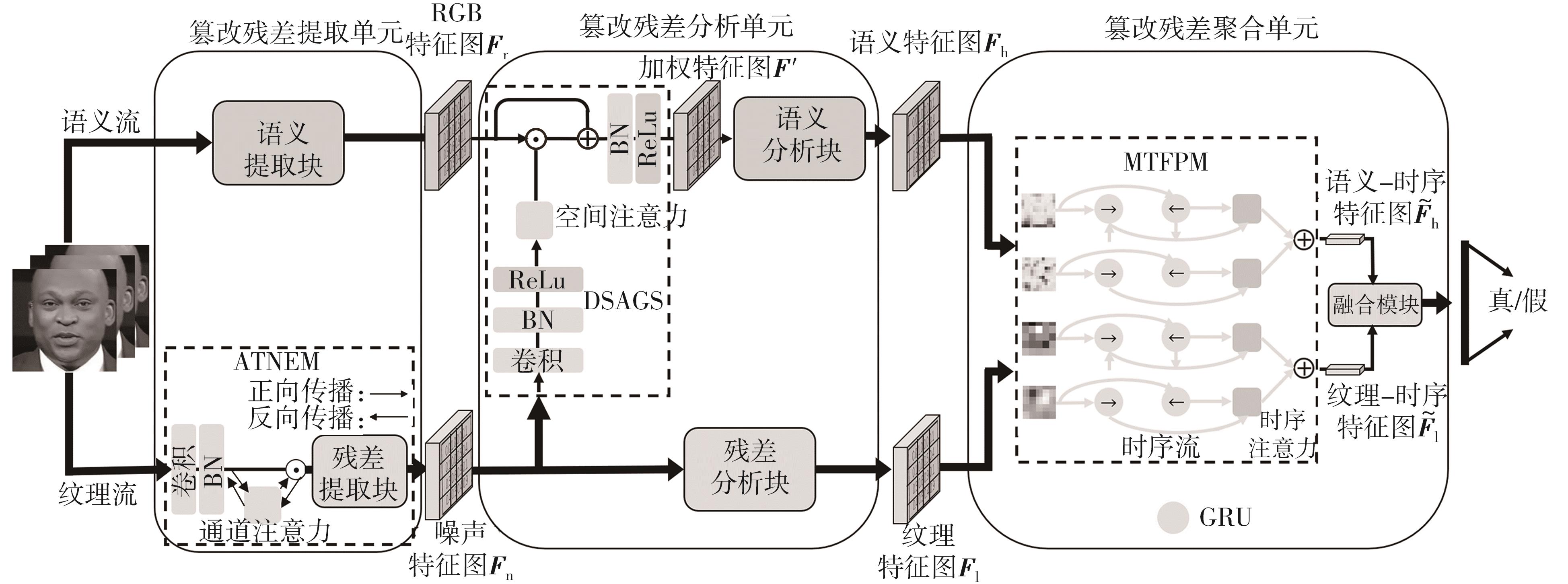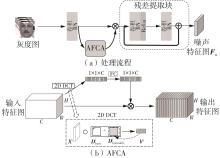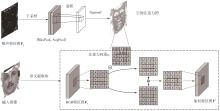Journal of South China University of Technology(Natural Science Edition) ›› 2023, Vol. 51 ›› Issue (9): 82-89.doi: 10.12141/j.issn.1000-565X.220825
• Computer Science & Technology • Previous Articles Next Articles
AdfNet: An Adaptive Deep Forgery Detection Network Based on Diverse Features
LI Jiachun LI Bowen LIN Weiwei
- School of Computer Science and Engineering,South China University of Technology,Guangzhou 510006,Guangdong,China
-
Received:2022-12-24Online:2023-09-25Published:2023-04-20 -
Contact:李家春(1968-),女,博士,副教授,主要从事计算机网络与信息安全、隐私保护、人工智能安全、智慧教学等研究。 E-mail:jclee@scut.edu.cn -
About author:李家春(1968-),女,博士,副教授,主要从事计算机网络与信息安全、隐私保护、人工智能安全、智慧教学等研究。 -
Supported by:Guangdong Provincial Key R&D Program(2021B0101420002);the Ministry of Education’s Cooperative Education Project(201902186007)
CLC Number:
Cite this article
LI Jiachun, LI Bowen, LIN Weiwei. AdfNet: An Adaptive Deep Forgery Detection Network Based on Diverse Features[J]. Journal of South China University of Technology(Natural Science Edition), 2023, 51(9): 82-89.
share this article
Table 1
Results of LQ and HQ mode tests on FF++ dataset %"
| 方法 | LQ | HQ | ||
|---|---|---|---|---|
| ACC | AUC | ACC | AUC | |
| MesoNet[ | 70.47 | — | 83.10 | — |
| SRNet[ | 73.56 | 78.60 | 95.02 | 97.04 |
| Xception[ | 85.80 | 88.68 | 94.27 | 96.41 |
| 文献 [ | 85.32 | 87.23 | 94.47 | 95.68 |
| 文献[ | 87.10 | 89.25 | 95.07 | 97.52 |
| 文献 [ | — | 86.95 | — | 98.70 |
| 文献[ | 87.03 | 88.36 | 96.68 | 98.99 |
| 文献[ | 87.25 | 88.79 | 95.61 | 98.12 |
| 文献[ | 81.57 | 82.82 | 91.50 | 95.32 |
| 文献[ | 87.81 | 85.39 | 94.90 | 98.37 |
| AdfNet | 88.43 | 91.53 | 97.41 | 99.38 |
Table 3
Cross-database evaluation on FF++ database (HQ) %"
| 训练集 | 方法 | 测试集 | ||||
|---|---|---|---|---|---|---|
| DF | F2F | FS | NT | FSH | ||
| DF | MesoNet | 97.63 | 46.55 | 60.70 | 77.49 | 69.74 |
| Xception | 99.31 | 74.56 | 38.69 | 75.36 | 62.88 | |
| AdfNet | 99.85 | 73.95 | 65.28 | 84.47 | 65.52 | |
| F2F | MesoNet | 74.00 | 97.78 | 53.57 | 63.67 | 54.13 |
| Xception | 81.74 | 99.38 | 57.94 | 69.08 | 62.59 | |
| AdfNet | 86.34 | 99.60 | 61.95 | 67.68 | 65.71 | |
| FS | MesoNet | 51.19 | 58.18 | 98.95 | 51.27 | 49.23 |
| Xception | 58.35 | 67.36 | 99.44 | 54.26 | 64.68 | |
| AdfNet | 60.41 | 66.85 | 99.71 | 58.38 | 57.39 | |
| NT | MesoNet | 87.54 | 61.92 | 49.30 | 86.86 | 63.88 |
| Xception | 84.65 | 69.78 | 46.83 | 98.19 | 70.55 | |
| AdfNet | 93.63 | 70.96 | 50.76 | 98.65 | 70.77 | |
| FSH | MesoNet | 78.33 | 45.83 | 47.90 | 65.31 | 95.13 |
| Xception | 74.13 | 47.36 | 50.39 | 64.62 | 99.35 | |
| AdfNet | 64.36 | 52.18 | 52.20 | 65.90 | 99.49 | |
Table 4
Ablation results of effectiveness of the proposed method"
| 方法 | DF(HQ) | F2F(HQ) | FS(HQ) | NT(HQ) | FSH(HQ) | |||||
|---|---|---|---|---|---|---|---|---|---|---|
| ACC | AUC | ACC | AUC | ACC | AUC | ACC | AUC | ACC | AUC | |
| 双流网络 | 98.13 | 98.67 | 97.87 | 98.01 | 98.01 | 98.83 | 93.80 | 97.99 | 97.07 | 99.43 |
| 双流网络+双向GRU | 98.59 | 99.36 | 98.78 | 99.34 | 98.97 | 99.33 | 94.09 | 98.65 | 97.64 | 99.49 |
| 双流网络+MTFPM | 98.92 | 99.80 | 98.80 | 99.53 | 98.95 | 99.74 | 94.48 | 98.52 | 97.76 | 99.63 |
| 双流网络+ATNEM | 98.64 | 99.70 | 98.88 | 99.56 | 98.79 | 99.57 | 94.34 | 98.46 | 97.12 | 99.51 |
| 双流网络+DSAGS | 98.77 | 99.76 | 98.75 | 99.50 | 98.55 | 99.54 | 94.19 | 98.15 | 97.41 | 99.55 |
| AdfNet | 99.15 | 99.87 | 98.99 | 99.60 | 99.12 | 99.75 | 94.85 | 98.67 | 97.90 | 99.49 |
Table 5
Detection results using video subsequences of different lengths"
| 伪造方法 | 单帧 | 连续两帧 | 连续3帧 | 连续4帧 | ||||
|---|---|---|---|---|---|---|---|---|
| ACC | AUC | ACC | AUC | ACC | AUC | ACC | AUC | |
| DF | 98.13 | 99.63 | 99.15 | 99.87 | 99.23 | 99.68 | 99.40 | 99.87 |
| F2F | 98.36 | 99.24 | 98.99 | 99.60 | 98.73 | 99.61 | 98.99 | 99.52 |
| FS | 98.51 | 99.72 | 99.12 | 99.75 | 99.13 | 99.82 | 99.05 | 99.77 |
| NT | 94.29 | 98.08 | 94.85 | 98.67 | 94.69 | 98.54 | 95.03 | 98.50 |
| FSH | 96.89 | 99.47 | 97.90 | 99.49 | 97.88 | 99.53 | 98.01 | 99.64 |
Table 6
Ablation results of different fusion methods"
| 方法 | DF(HQ) | F2F(HQ) | FS(HQ) | NT(HQ) | FSH(HQ) | |||||
|---|---|---|---|---|---|---|---|---|---|---|
| ACC | AUC | ACC | AUC | ACC | AUC | ACC | AUC | ACC | AUC | |
| 逐点相加 | 98.88 | 99.64 | 98.22 | 99.11 | 98.15 | 99.23 | 94.33 | 97.90 | 97.23 | 99.50 |
| 拼接 | 98.83 | 99.69 | 98.47 | 99.22 | 98.63 | 99.69 | 94.45 | 98.44 | 97.86 | 99.54 |
| 双线性池化 | 98.94 | 99.65 | 98.84 | 99.29 | 98.72 | 99.81 | 94.53 | 97.94 | 97.77 | 99.53 |
| 注意力特征融合 | 99.15 | 99.87 | 98.99 | 99.60 | 99.12 | 99.75 | 94.85 | 98.67 | 97.90 | 99.49 |
| 1 | KORSHUNOV P, MARCEL S .Deepfakes:a new threat to face recognition?assessment and detection[EB/OL].(2018-12-20)[2022-09-01].. |
| 2 | 胡永健, SALMAN Alhamidi,王宇飞,等 .视频篡改检测数据库的构建及测试[J].华南理工大学学报(自然科学版),2017,45(12):57-64. |
| HU Yong-jian, SALMAN Alhamidi, WANG Yu-fei,et al .Construction and evaluation of video forgery detection database[J].Journal of South China University of Technology (Natural Science Edition),2017,45(12):57-64. | |
| 3 | WANG J, SUN Y, TANG J .LISIAM:Localization invariance Siamese network for deepfake detection[J].IEEE Transactions on Information Forensics and Security,2022,17:2425-2436. |
| 4 | 陆璐,钟文煜,吴小坤 .基于多尺度视觉Transformer的图像篡改定位[J].华南理工大学学报(自然科学版),2022,50(6):10-18. |
| LU Lu, ZHONG Wenyu, WU Xiaokun .Image tampering localization based on mutil-scale transformer[J].Journal of South China University of Technology(Natural Science Edition),2022,50(6):10-18. | |
| 5 | YANG J, XIAO S, LI A,et al .Detecting fake images by identifying potential texture difference[J].Future Generation Computer Systems,2021,125:127-135. |
| 6 | COZZOLINO D, POGGI G, VERDOLIVA L .Recasting residual-based local descriptors as convolutional neural networks:An application to image forgery detection[C]∥Proceedings of the 5th ACM Workshop on Information Hiding and Multimedia Security.Philadelphia:ACM,2017:159-164. |
| 7 | BAYAR B, STAMM M C .A deep learning approach to universal image manipulation detection using a new convolutional layer[C]∥Proceedings of the 4th ACM Workshop on Information Hiding and Multimedia Security.Vigo:ACM,2016:5-10. |
| 8 | AFCHAR D, NOZICK V, YAMAGISHI J,et al .Mesonet:A compact facial video forgery detection network[C]∥Proceedings of the 2018 IEEE International Workshop on Information Forensics and Security (WIFS).Hong Kong:IEEE,2018:1-7. |
| 9 | CHOLLET F .Xception:Deep learning with depthwise separable convolutions[C]∥Proceedings of the IEEE Conference on Computer Vision and Pattern Recognition. Honolulu:IEEE,2017:1251-1258. |
| 10 | MASI I, KILLEKAR A, MASCARENHAS R M,et al .Two-branch recurrent network for isolating deepfakes in videos[C]∥Proceedings of the European Conference on Computer Vision.Glasgow:Springer,2020:667-684. |
| 11 | ZHAO H, ZHOU W, CHEN D,et al .Multi-attentional deepfake detection[C]∥Proceedings of the IEEE/CVF Conference on Computer Vision and Pattern Recognition.Kuala Lumpur:IEEE,2021:2185-2194. |
| 12 | WU X, XIE Z, GAO Y T,et al .Sstnet:Detecting manipulated faces through spatial,steganalysis and temporal features[C]∥Proceedings of the 2020 IEEE International Conference on Acoustics,Speech and Signal Processing (ICASSP).Barcelona:IEEE,2020:2952-2956. |
| 13 | GÜERA D, DELP E J .Deepfake video detection using recurrent neural networks[C]∥Proceedings of the 2018 15th IEEE International Conference on Advanced Video and Signal Based Surveillance (AVSS).Auckland:IEEE,2018:1-6. |
| 14 | SABIR E, CHENG J, JAISWAL A,et al .Recurrent convolutional strategies for face manipulation detection in videos[J].Interfaces (GUI),2019,3(1):80-87. |
| 15 | ROSSLER A, COZZOLINO D, VERDOLIVA L,et al .FaceForensics++:Learning to detect manipulated facial images[C]∥Proceedings of the IEEE/CVF International Conference on Computer Vision.Calif:IEEE,2019:1-11. |
| 16 | LI Y, YANG X, SUN P,et al .Celeb-DF:A large-scale challenging dataset for deepfake forensics[C]∥Proceedings of the IEEE/CVF Conference on Computer Vision and Pattern Recognition.Seattle:IEEE,2020:3207-3216. |
| 17 | DENG J, DONG W, SOCHER R,et al .ImageNet:A large-scale hierarchical image database[C]∥Proceedings of the 2009 IEEE Conference on Computer Vision and Pattern Recognition.Miami:IEEE,2009:248-255. |
| 18 | BOROUMAND M, CHEN M, FRIDRICH J .Deep residual network for steganalysis of digital images[J].IEEE Transactions on Information Forensics and Security,2018,14(5):1181-1193. |
| 19 | QIN Z, ZHANG P, WU F,et al .Fcanet:Frequency channel attention networks[C]∥Proceedings of the IEEE/CVF International Conference on Computer Vision.Montreal:IEEE,2021:783-792. |
| 20 | LIU H, LI X, ZHOU W,et al .Spatial-phase shallow learning:Rethinking face forgery detection in frequency domain[C]∥Proceedings of the IEEE/CVF Conference on Computer Vision and Pattern Recognition.Kuala Lumpur:IEEE,2021:772-781. |
| 21 | QIAN Y, YIN G, SHENG L,et al .Thinking in frequency:Face forgery detection by mining frequency-aware clues[C]∥Proceedings of the European Conference on Computer Vision.Glasgow:Springer,2020:86-103. |
| 22 | TAN M, LE Q .Efficientnet:Rethinking model scaling for convolutional neural networks[C]∥Proceedings of the International Conference on Machine Learning. New York:PMLR,2019:6105-6114. |
| 23 | TRINH L, TSANG M, RAMBHATLA S,et al .Interpretable and trustworthy deepfake detection via dynamic prototypes[C]∥Proceedings of the IEEE/CVF Winter Conference on Applications of Computer Vision.Montreal:IEEE,2021:1973-1983. |
| 24 | NGUYEN H H, FANG F, YAMAGISHI J,et al .Multi-task learning for detecting and segmenting manipulated facial images and videos[C]∥Proceedings of the 2019 IEEE 10th International Conference on Biometrics Theory,Applications and Systems (BTAS).Tampa:IEEE,2019:1-8. |
| 25 | CHO K, VAN M B, GULCEHRE C,et al .Learning phrase representations using RNN encoder-decoder for statistical machine translation[EB/OL].(2014-09-03)[2022-09-01].. |
| 26 | LIN T Y, ROYCHOWDHURY A, MAJI S .Bilinear CNN models for fine-grained visual recognition[C]∥Proceedings of the IEEE International Conference on Computer Vision.Santiago:IEEE,2015:1449-1457. |
| 27 | DAI Y, GIESEKE F, OEHMCKE S,et al .Attentional feature fusion[C]∥Proceedings of the IEEE/CVF Winter Conference on Applications of Computer Vision.Montreal:IEEE,2021:3560-3569. |
| [1] | LI Haiyan, YIN Haolin, LI Peng, et al.. Image Inpainting Algorithm Based on Dense Feature Reasoning and Mix Loss Function [J]. Journal of South China University of Technology(Natural Science Edition), 2023, 51(9): 99-109. |
| [2] | LI Fang, GUO Weisen, ZHANG Ping, et al.. Prediction Technique for Remaining Useful Life of Bearing Based on Spatial-Temporal Dual Cell State [J]. Journal of South China University of Technology(Natural Science Edition), 2023, 51(9): 69-81. |
| [3] | SU Jindian, YU Shanshan, HONG Xiaobin. A Self-Supervised Pre-Training Method for Chinese Spelling Correction [J]. Journal of South China University of Technology(Natural Science Edition), 2023, 51(9): 90-98. |
| [4] | GUO Enqiang, FU Xinsha. Dropped Object Detection Method Based on Feature Similarity Learning [J]. Journal of South China University of Technology(Natural Science Edition), 2023, 51(6): 30-41. |
| [5] | ZHAO Jiandong, JIAO Lanxin, ZHAO Zhimin, et al. A Car-Following Model Driven by Combination of Theory and Data Considering Effects of Lane Change of Side Cars [J]. Journal of South China University of Technology(Natural Science Edition), 2023, 51(6): 10-19. |
| [6] | LU Lu, LAI Jinxiong. Smart Contract Vulnerability Detection Method Based on Capsule Network and Attention Mechanism [J]. Journal of South China University of Technology(Natural Science Edition), 2023, 51(5): 36-44. |
| [7] | YE Feng, CHEN Biao, LAI Yizong. Contrastive Knowledge Distillation Method Based on Feature Space Embedding [J]. Journal of South China University of Technology(Natural Science Edition), 2023, 51(5): 13-23. |
| [8] | LIU Yupeng, ZHANG Lei. Cognitive Diagnosis Model Integrating Forgetting and Importance of Knowledge Points [J]. Journal of South China University of Technology(Natural Science Edition), 2023, 51(5): 54-62. |
| [9] | HOU Liwei, WANG Hengsheng, ZOU Haoran. Deep Learning-Based Prediction of Contact Force in the Process of Shoveling Up Glass Subtrate [J]. Journal of South China University of Technology(Natural Science Edition), 2022, 50(8): 71-81. |
| [10] | MO Jianwen, ZHU Yanqiao, YUAN Hua, et al. Incremental learning based on neuron regularization and resource releasing [J]. Journal of South China University of Technology(Natural Science Edition), 2022, 50(6): 71-79,90. |
| [11] | LU Lu, ZHONG Wenyu, WU Xiaokun. Image tampering localization based on mutil-scale transformer [J]. Journal of South China University of Technology(Natural Science Edition), 2022, 50(6): 10-18. |
| [12] | ZHANG Qin, HU Jiahui, REN Hailin. Intelligent Pushing Method and Experiment of Feeding Assistant Robot [J]. Journal of South China University of Technology(Natural Science Edition), 2022, 50(6): 111-120. |
| [13] | YANG Chunling, LING Xi, LÜ Zeyu. Feature-domain Multi-Hypothesis Prediction Reconstruction Neural Network for Compressed Video Sensing [J]. Journal of South China University of Technology(Natural Science Edition), 2022, 50(6): 80-90. |
| [14] | WO Yan, LIANG Jiyun, HAN Guoqiang. A cross-modal face retrieval method based on metric learning [J]. Journal of South China University of Technology(Natural Science Edition), 2022, 50(6): 1-9. |
| [15] | ZHAO Jiandong, ZHU Dan, LIU Jiaxin. Metro Transfer Passenger Flow Prediction Based on STL-GRU [J]. Journal of South China University of Technology(Natural Science Edition), 2022, 50(5): 22-31. |
| Viewed | ||||||
|
Full text |
|
|||||
|
Abstract |
|
|||||





